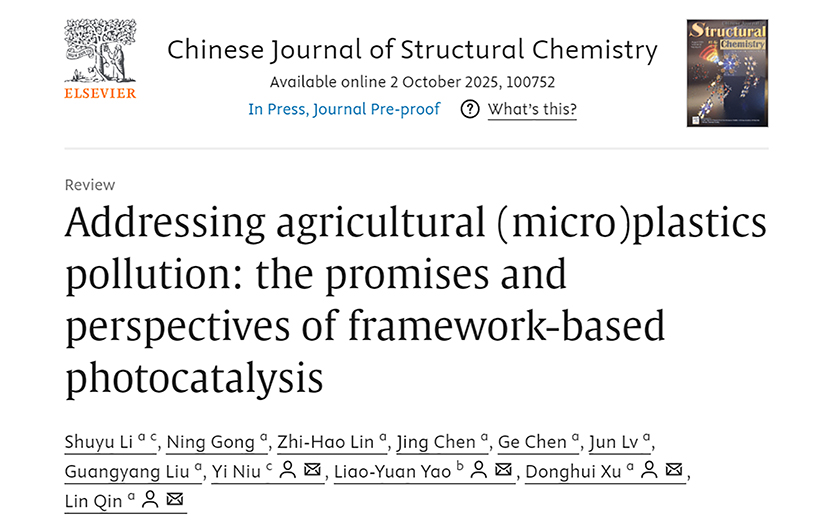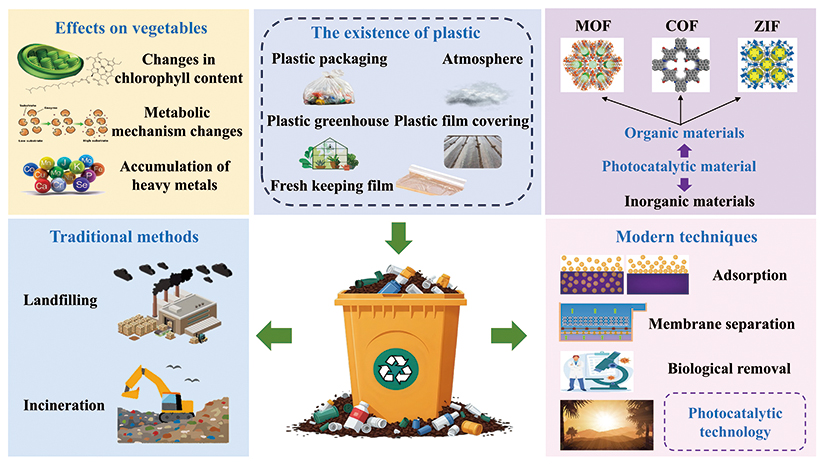Recently, the quality and safety research team at the institute of vegetables and flowers, chinese academy of agricultural sciences, has achieved research progress in addressing agricultural microplastic pollution with framework-based photocatalytic platforms. The related research findings have been published in the Chinese Journal of Structural Chemistry (Impact Factor: 10.3, Q1) with the title “Addressing agricultural (micro)plastics pollution: the promises and perspectives of framework-based photocatalysis”

Plastic pollution has emerged as a global environmental crisis, with microplastics (MPs) infiltrating agricultural ecosystems through multiple pathways, including atmospheric deposition, irrigation water, soil contamination, and the degradation of plastic mulches. These particles smaller than 5 mm in size are absorbed and accumulated by agricultural crops. This uptake compromises the quality, safety, and nutritional value of agricultural products, ultimately entering the human body through the food chain and posing potential health risks. As a critical component of a healthy diet, vegetables provide approximately 41% of daily nutritional intake, serving as a cornerstone of human nutrition. In light of the escalating issue of microplastic contamination in vegetable products, there is an urgent need to develop efficient and green remediation technologies. Such advancements are essential to ensuring agricultural product quality and safety and promoting the sustainable development of agriculture.

Addressing the challenges, this article proposes photocatalysis as a promising green strategy. In contrast to conventional high energy consumption methods such as incineration and landfilling that often cause secondary pollution and the limitations of adsorption and membrane separation technologies in terms of efficiency and cost, photocatalysis offers a clean and low energy alternative particularly suitable for agricultural environments. The significance of photocatalysis technology lies in designing high performance catalysts that could utilize solar energy to drive catalytic reactions, progressively degrading microplastics from stable polymers until complete mineralization. Among various catalytic materials, metal-organic frameworks (MOFs), covalent organic frameworks (COFs), and their derivatives (e.g., ZIFs) have demonstrated remarkable potential. Their tunable pore structures, high specific surface areas, and excellent light responsive properties make them a research focus for novel photocatalyst development. With precise design of active sites and construction of heterojunctions to enhance charge separation efficiency, this approach not only enables complete mineralization of microplastics but also produces valuable chemicals such as formic acid and benzoic acid. Furthermore, the article outlines challenges in utilizing framework-based photocatalysis from laboratory to practical application, including long-term catalyst stability, scalable reactor design, and efficient utilization of sunlight. This review aims to offer the oretical foundations and technical insights to address the global challenge of microplastic pollution, contributing to the development of sustainable solutions for environmental and agricultural fields.
The Institute of Vegetables and Flowers, Chinese Academy of Agricultural Sciences is the first affiliation of this paper. This research was supported by Key Laboratory of Vegetables Quality and Safety Control, Ministry of Agriculture and Rural Affairs, grants from The Agricultural Science and Technology Innovation Program (ASTIP), Development Program of China, the Special Fund for the Industrial System Construction of Modern Agriculture of China, National Center of Technology Innovation for Comprehensive Utilization of Saline-Alkali.
The article link:https://doi.org/10.1016/j.cjsc.2025.100752